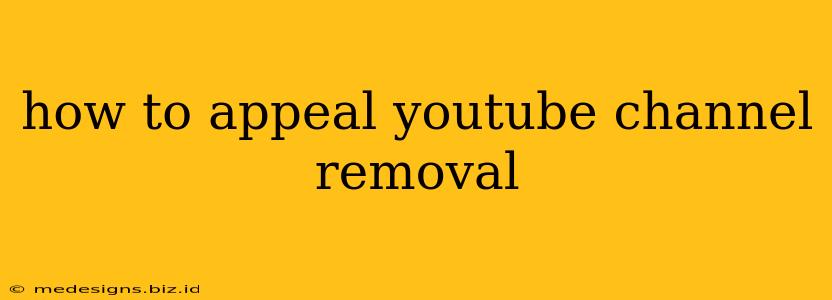Having your YouTube channel removed can feel devastating, especially if you've poured time and effort into building your audience. But don't despair! Understanding the YouTube appeals process and crafting a compelling case significantly increases your chances of getting your channel reinstated. This guide will walk you through the process, providing actionable steps and advice to maximize your success.
Understanding Why Your Channel Was Removed
Before you even start writing your appeal, you must understand why YouTube removed your channel. The notification you received should clearly state the violation(s) that led to the termination. Common reasons include:
- Community Guidelines violations: These cover a wide range, from copyright infringement and hate speech to spam and harassment.
- Terms of Service violations: This includes things like using unauthorized software or engaging in deceptive practices.
- Repeated or serious violations: Even minor infractions can lead to termination if they're repeated.
Identifying the specific violation is crucial. Your appeal needs to directly address the issue YouTube cited. Generic appeals are unlikely to succeed.
Crafting Your YouTube Channel Reinstatement Appeal
Your appeal needs to be professional, respectful, and persuasive. Here's a breakdown of what to include:
1. Clearly State Your Case:
Start by acknowledging the violation. Don't deny it if you're guilty; instead, demonstrate remorse and understanding of YouTube's policies. For example: "I understand my channel was terminated due to a violation of the Community Guidelines regarding copyright infringement."
2. Explain the Circumstances:
Provide context. Explain how the violation occurred. Was it unintentional? Did you misunderstand the rules? Be honest and transparent. For instance: "The copyrighted music was used unintentionally. I was unaware of the necessary licensing requirements and have since removed the offending video."
3. Demonstrate Understanding and Commitment to Compliance:
This is crucial. Show YouTube you've learned from your mistake. Examples include:
- For copyright infringement: Explain how you'll use royalty-free music or obtain proper licensing in the future. Mention specific tools or resources you'll utilize.
- For hate speech: State your commitment to promoting inclusivity and tolerance, and outline steps you'll take to prevent future violations.
- For spam: Explain how you'll avoid engaging in manipulative practices going forward.
4. Provide Evidence of Your Commitment:
This is where you solidify your appeal. Back up your claims with evidence. This might include:
- Screenshots: Show removed videos or altered channel content.
- Links: Point to resources you've used to learn more about YouTube's policies.
- Policy updates: Show that you've updated your channel to comply with current guidelines.
5. Maintain a Professional Tone:
Avoid being aggressive or defensive. A respectful and humble tone is much more likely to be successful.
6. Proofread Carefully:
Errors can undermine your credibility. Thoroughly proofread your appeal before submitting it.
Submitting Your Appeal
Follow YouTube's instructions carefully. Usually, there's a specific form or email address to use. Make sure you clearly state your channel name and URL.
What to Do While You Wait
While waiting for a response, consider these actions:
- Review YouTube's policies: Familiarize yourself with all relevant guidelines to prevent future violations.
- Seek advice: Consult with other creators or legal professionals if necessary.
- Prepare for the worst: While you hope for reinstatement, develop a backup plan in case your appeal is unsuccessful. This might include creating a new channel.
Appealing a YouTube channel removal requires careful preparation and a persuasive presentation. By following these steps and demonstrating your commitment to complying with YouTube's policies, you significantly increase your chances of a successful appeal. Remember, patience and persistence are key. Good luck!
